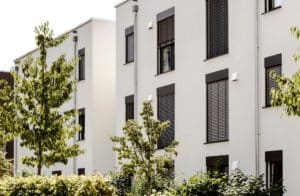As society endeavours to move closer to net-zero buildings, could transparent solar panels replace windows for good?
Transparent solar panels – they sound pretty incredible, right? What may seem like a concept from science fiction is very much on track to change the landscape of sustainable construction: so much so that scientists in the US and Europe have actually achieved 100% transparency for solar glass, moving us closer and closer to net-zero buildings.
So, what are transparent solar panels and why could they hold the key to a future free from fossil fuels?
RELATED: WHICH ROOFS ARE (AND AREN’T) SUITABLE FOR SOLAR PANELS?
What are transparent solar panels?
Transparent solar panels are a cutting edge and innovative form of technology that soaks up and utilises light energy through any glass surface, no matter the angle.
There’s been a huge deal of work and research poured into developing the technology, with several methods available. Typically, transparent solar panels can be better understood as a transparent solar contractor; this means that they can gather specific UV and infrared light wavelengths that cannot be seen by the naked eye. They then transform this UV and light wavelengths into energy that can be used to power electronics.
This is enormous for the industry and the world as a whole. Glass is everywhere – the prospect of integrating transparent solar panels in the place of ‘normal’ glass could totally transform the built environment as we know it.
What are the benefits of transparent solar panels?
The benefits of transparent solar panels are h-u-g-e. Just take a look around you – the phone that you’re holding or the screen that you’re reading from: glass. That mirror on the wall: glass. Windows, skyscrapers, appliances and interior design: glass, glass and more glass.
Now – imagine if these items (big and small) could also harness the power of solar and transform it into efficient energy.
Another benefit is that while traditional solar panels call for a hefty space to set up, transparent solar panels are relatively easy to install within a smaller space and at a lower cost. Plus, let’s face it: traditional panels can be a bit of an eyesore. Transparent solar panels, on the other hand, seamlessly fit in with the rest of a building or item’s aesthetic. They also, of course, let in more natural light and have a versatile selection of uses.
What are the disadvantages of transparent solar panels?
The disadvantages of transparent solar panels can largely be seen as obstacles – ones that, with time, will be fixed. Primarily this comes down to their efficiency.
At present, there is an efficiency/transparency tradeoff. While scientists have excitingly achieved 100% transparent solar panels, the repercussions are that these panels aren’t as efficient as one might expect – certainly in comparison to traditional solar panels. It’s unlikely that their efficiency will exceed what we’re used to with traditional solar panels, however progress looks promising. Whatever the outcome, the technology could mean enormous things for the world of energy efficiency in the construction industry: benefits that are already being felt worldwide.
Transparent solar panel examples.
The reality of widespread transparent solar panels in the UK is closer than you might think.
The Copenhagen International School’s design utilises 12,000 hued but clear solar panels all over the building, producing 200 MWh of energy annually — this is reported to be over half of the energy the building consumes.
More recently, the Biomedical and Physical Sciences Building on the campus of Michigan State University was upgraded with the installation of 100-square-feet transparent solar glass panels which were situated above the building’s entryway. The plan is that these will generate enough electricity to power the lighting in its atrium.
Where next? We can’t wait to find out.




















